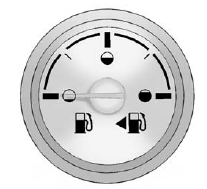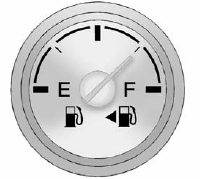Chevrolet Captiva Owners Manual: Fuel Gauge

Metric

English
When the ignition is on, the fuel gauge indicates how much fuel is left in the tank.
When the indicator nears empty, the low fuel light comes on. There is still a little fuel left, but the fuel tank should be refilled soon. See Low Fuel Warning Light on page 5-21 for more information.
An arrow on the fuel gauge indicates the side of the vehicle the fuel door is on.
Here are four things that some owners ask about. None of these means the fuel gauge is not working properly:
- At the service station, the fuel pump shuts off before the gauge reads full.
- It takes a little more or less fuel to fill up than the gauge indicated. For example, the gauge may have indicated the tank was half full, but it actually
- took a little more or less than half the tank's capacity to fill the tank.
- The gauge moves a little while turning a corner or speeding up.
- The gauge takes a few seconds to stabilize after the ignition is turned on, but it goes back to empty when the ignition is turned off.
For fuel tank capacity, see Capacities and Specifications on page 12-2.
The fuel gauge in a Chevrolet Captiva (2006-2018) is an essential component that provides drivers with crucial information about the fuel level in the vehicle's tank. It typically consists of a needle or digital display on the instrument cluster that indicates the amount of fuel remaining.
To ensure accurate readings, it's important to understand how the fuel gauge works. The gauge is connected to a fuel level sensor inside the fuel tank. As fuel is consumed, the sensor sends a signal to the gauge, which then displays the corresponding fuel level.
It's essential to keep the fuel gauge in good working condition by regularly checking for any signs of malfunction. Common issues with the fuel gauge include inaccurate readings, a stuck needle, or a gauge that doesn't move at all. These issues could be caused by a faulty fuel level sensor, wiring problems, or a malfunctioning gauge itself.
If you notice any abnormalities with your fuel gauge, it's recommended to have it inspected and repaired by a qualified mechanic. Ignoring fuel gauge problems can lead to inaccurate fuel level readings, which may result in running out of fuel unexpectedly or other potential issues on the road. Regular maintenance and prompt repairs ensure the fuel gauge operates correctly, providing accurate information to the driver for a safe and hassle-free driving experience.
 Odometer, Trip Odometer
Odometer, Trip Odometer
Odometer
The odometer shows how far the vehicle has been driven, in either kilometers or miles.
This vehicle has a tamper-resistant odometer. If the vehicle needs a new odometer installed, the new ...
 Safety Belt Reminders, Airbag Readiness Light
Safety Belt Reminders, Airbag Readiness Light
Safety Belt Reminders
Driver Safety Belt Reminder
Light
There is a driver safety belt
reminder light on the instrument
cluster.
When the vehicle is
started this light
flashes and a chime m ...
More about:
Chevrolet Captiva Service & Repair Manual > Brakes: Parking Brake System Adjust
Adjustment procedure
If the rear wheels rotate during the following test, repeat the adjustment procedure completely.
1.
...
Chevrolet Captiva Owners Manual
- Introduction
- In Brief
- Keys, Doors, and Windows
- Seats and Restraints
- Storage
- Instruments and Controls
- Lighting
- Infotainment System
- Climate Controls
- Driving and Operating
- Vehicle Care
- Service and Maintenance
- Technical Data
- OnStar
